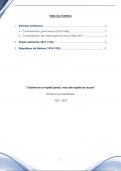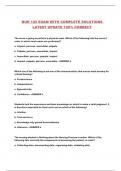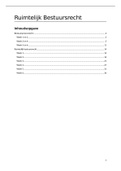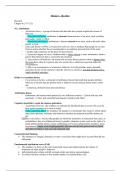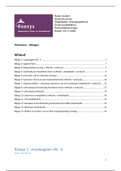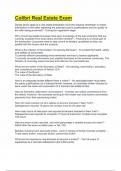TABLE OF CONTENTS
Chapter 1 Introduction 5
CH1-1. What is international economics about? 5
CH1-1.1. International Trade 5
CH1-1.1.1. Advantages and disadvantages of international trade? 6
CH1-1.1.2. The pattern of trade 7
CH1-1.1.3. How much trade? Is there a need for government policy? 7
CH1-1.2. International Finance 7
CH1-2. Course overview + course restrictions (due to limited number of hours) 8
Chapter 2 World trade: an overview 8
CH2-1. Who trades with whom? 8
CH2-1.1. The gravity model: size and distance 8
CH2-1.1.2. What do the empirics tell us? 8
CH2-1.1.2. What does the theory tell us? 10
CH2-1.1.3. What other factors can influence trade? 11
CH2-1.2. Impediments to trade: borders 11
CH2-2. The changing pattern of World Trade (DON’T NEED TO KNOW) 13
CH2-3. Summary 13
Chapter 3 Labour Productivity and Comparative Advantage: The Ricardian Model 14
CH3-1. Introduction 14
CH3-2. Who was Ricardo ?: In what time period and social context did he write down his ideas ? (not for
exam) 14
CH3-3. Today: 200 years later: Is his idea so weird? (not for exam) 14
CH3-4. The model of Ricardo: assumptions and concepts 15
CH3-4.1. Assumptions 15
CH3-4.2. The labour input per unit 15
CH3-4.3. Labour productivity 15
CH3-4.4. The opportunity cost 16
CH3-4.5. Absolute versus comparative advantage 16
CH3-4.6. The Production Possibilities Frontier (PPF) and the supply of goods in autarchy 18
CH3-5. The Ricardo model (or “1-factor economy”) in 1 country (autarky) 20
CH3-6. International trade in the Ricardian model (or a “1-factor world”) 21
CH3-6.1. The pattern of trade is determined by comparative advantage 21
CH3-6.2. Determination of the relative price after trade (with trade) and the supply of goods in both
countries 22
, CH3-6.3. The gains of trade 26
CH3-6.4. The relative wages 30
CH3-7. Misconceptions about comparative advantage 31
CH3-7.1. Productivity and competitiveness 31
CH3-7.2. Labour argument (‘Pauper labour argument’) 32
CH3-7.3. Exploitation 32
CH3-8. Transportation costs and non-tradable goods 32
CH3-9. Empirical evidence w.r.t. the Ricardian model 32
CH3-10. Summary 34
Chapter 4 Specific factors and income distribution 35
CH4-1. Introduction 35
CH4-2. The assumptions of the Specific Factors Model 35
CH4-3. The Specific Factors Model in 1 country (autarky) 36
CH4-3.1. Production possibilities 36
CH4-3.2. Labour allocation and the supply of the goods under autarchy 39
CH4-3.3. Relative prices and labour allocation 41
CH4-3.4. Relative prices and income distribution 42
CH4-4. International trade in the Specific Factors Model 43
CH4-4.1. Determination of the relative price after trade and the supply of the goods in both countries 43
CH4-4.2. Income distribution and the gains from trade 46
CH4-5. Summary 48
Chapter 5 Resources and trade: The Heckser-Ohlin mode 49
CH5-1. Introduction 49
CH5-2. The assumptions of the Heckser-Ohlin model 49
CH5-3. The model of a two-factor economy in 1 country 49
CH5-3.1. The assumptions 49
CH5-3.1.1. Factor intensity versus factor abundance 50
CH5-3.1.2. The production possibilities frontier (PPF) 50
CH5-3.2. The choice of the mix of production factors (inputs) 51
CH5-3.2.1. The link between factor prices and use of production factors 52
CH5-3.2.2. The link between prices of goods and factor prices 53
CH5-3.2.3. The link between prices of goods, factor prices and use of production factors 54
CH5-3.2.4. The link between use of production factors and output produced 55
CH5-3.3. How is the allocation of the production factors determined? 56
CH5-4. International trade between ‘2-factor economies’ 59
CH5-4.1. The pattern of trade: without versus with trade 59
CH5-4.2. Trade and income distribution 61
2
, CH5-4.3. Trade and increased income inequality in rich countries 61
CH5-4.4. Exercise (exam type) 63
CH5-4.5. Factor price equalization 63
CH5-5. Empirical evidence of the Heckser-Ohlin model 65
CH5-5.1. Trade in goods as a substitute for trade in production factors 65
CH5-5.1.1. Tests on US data (1962) 65
CH5-5.1.2. Tests on global data (1987) 66
CH5-5.1.3. The case of ‘missing’ trade (1995) 67
CH5-5.2. Export patterns between developed and developed countries 68
CH5-5.2.1. North-South trade 68
CH5-5.2.2. Changes over time also follow the Heckser-Ohlin model 69
CH5-5.3. Implications of the tests 70
CH5-6. Summary 70
Chapters 7 & 8 External (7) and Internal (8) Economies of Scale 72
CH7/8-1. Introduction 72
CH7/8-2. Economies of scale and international trade 72
CH7/8-3. Economies of scale and market structure 73
CH7-4. External Economies of scale / external economies (Chapter 7) 73
CH7-4.1. Definition and examples 73
CH7-4.2. Three reasons for external economies 74
CH7-4.2.1. Specialized providers (equipment or services) 74
CH7-4.2.2. Labour pooling 74
CH7-4.2.3. Knowledge spillovers 75
CH7-4.3. External economies of scale and international trade 75
CH7-4.3.1. The supply curve 75
CH7-4.3.2. External economies of scale and the pattern of trade 75
CH7-4.3.3. Trade and (national) welfare under external economies of scale 79
CH7-4.3.4. Dynamic increasing returns to scale 79
CH8-5. Internal Economies of scale (Chapter 8) 80
CH8-5.1. Monopolistic competition 80
CH8-5.2. Internal economies of scale (monopolistic competition) and trade 82
CH8-5.3. What is the difference in the pattern of trade under ‘comparative advantage’ (ch. 3-5) versus
‘internal economies of scale’ (monopolistic competition) (ch. 8)? 83
CH8-5.3.1. According to Heckscher-Ohlin and Ricardo 83
CH8-5.3.2. Assumption: the global apparel industry works under monopolistic competition 84
CH8-5.3.3. Main differences between inter- and intra-industrial trade 84
CH8-5.3.4. The significance and importance of intra-industrial trade 85
CH8-5.4. Costs of trade and export decisions 86
CH7/8-6. Summary 88
3
,Chapter 9 The Instruments of Trade Policy 89
CH9-1. Introduction 89
CH9-2. Types of barriers to trade 89
CH9-3. Cost – benefit analysis of a tariff (customs duty) 90
CH9-3.1. Effect of a customs duty in a small importing country 91
CH9-3.2. Effect of a customs duty in a large importing country 94
CH9-4. Summary 96
4
,CHAPTER 1 INTRODUCTION
CH1-1. WHAT IS INTERNATIONAL ECONOMICS ABOUT?
International economics studies economic interactions between countries and the problems that may arise
Trade in goods and services
(‘International Trade’)
+
Trade in financial flows and investments
(‘International Finance’)
At the beginning of the 21st century, countries are more interconnected than ever, through trade in goods and
services, through capital flows and through investments
Figure 1.1.: Export and Import as a percentage of US national income
Data from 2015 Data from 2019
‘international trade’
- International trade has tripled since 1960
- Both imports and exports fell in 2009 due to the recession
- Import increase > export increase
‘international finance’
- How does the US pay for this import
→ influx of foreign capital
→ growing links between national capital markets
CH1-1.1. INTERNATIONAL TRADE
Figure 1.2.: Average of Exports and Imports as Percentage of National Income in 2015
2015
In comparison to the US, other countries depend more on
international trade
5
, 2019:
Same finding: In comparison to the US, other countries depend
more on international trade.
Why has international trade risen so sharply?
1. A decrease in trade barriers, such as tariffs and quotas, …
2. A reduction in transport costs (decrease in air fares, costs of tanker transport, costs for the use of information technology)
3. The creation of free trade areas (EU, NAFTA, CETA, etc.)
CH1-1.1.1. ADVANTAGES AND DISADVANTAGES OF INTERNATIONAL TRADE?
→ The following advantages and disadvantages will be covered throughout this course.
→ Some seem logical, others not.
→ By the end of this course these advantages and disadvantages should be clear to everyone.
A. Advantages (=Gains)
1. When a buyer and a seller engage in a voluntary transaction, both can be made better off
- Norwegian consumers import lemons that they would have a hard time producing
- The producers of lemons receive an income that can use to buy other things
2. Even if a country is the most (or least) efficient in the production of ALL goods, it wins from free trade
- Even when producers in the less efficient country can only compete by paying lower wages
- Each country will produce that good/those goods in which it is relatively the best and it will
import the rest
o Countries use their resources to produce those goods in which they are most productive at
(compared to their other production choices), then trade those products for goods and services that
they want to consume
o Countries can specialize in the production of a limited amount of goods, while consuming
many goods and services through trade
- So the idea that trade is harmful when there are major productivity and wage inequalities
between countries is wrong
3. Trade will be beneficial to a country when it exports (imports) goods that make use of abundant
(scarce) production factors
4. If countries specialize, they can be more efficient through production on a larger scale
(= scale economies)
5. Countries can also win by trading current production factors, goods, money, etc. against future production
factors, goods, etc.
6
,B. Disadvantages (=Losses)
Trade is beneficial to individual countries, but may be detrimental to certain groups of economic agents within
countries (the distribution of benefits may vary)
1. International trade can harm the owners of resources that are used relatively intensively in industries
that compete with imports
2. Trade may therefore affect the distribution of income within a country
3. Rather than between countries, trade conflicts should occur between groups within a given country
CH1-1.1.2. THE PATTERN OF TRADE
Pattern of trade = ‘who sells what to whom?’
Trade can be explained by:
▪ Differences in climate (inter-industrial trade)
o E.g. Brazil exports coffee and Australia exports iron ore
o Not always: e.g. who does Japan export cars and US aircraft?
▪ Differences in labour productivity (inter-industrial trade)
▪ Differences in availability and use of production factors (inter-industrial trade)
▪ Economies of scale (intra-industrial trade)
Inter industrial trade: trade between 2 different products: e.g. cloths against food (BETWEEN)
Intra industrial trade: trade between 2 similar products: e.g. Ferrari vs Volvo (WITHIN)
CH1-1.1.3. HOW MUCH TRADE? IS THERE A NEED FOR GOVERNMENT POLICY?
= How much trade is allowed so that it cannot cause damage? → ???
- On the one hand, since WW2, industrialized countries have tried to remove obstacles to international
trade through all kinds of ‘agreements’ between a few countries or on a ‘world scale’
(e.g. NAFTA, GATT, …)
- On the other hand, governments are concerned about the impact of international trade on the
prosperity of domestic industries
→They have regularly tried to counteract trade:
o E.g. mercantilism, protectionism
o E.g. Think of the statements of Trump during his presidency!
- At the same time, the anti-globalist movement has gained a lot of influence (°1999 in Seattle)
➔Hence, policy makers will try to affect the amount of trade through:
- Tariffs : a tax on imports or exports
- Quotas : a quantity restriction on imports or exports
- Export subsidies : a payment to producers that export
CH1-1.2. INTERNATIONAL FINANCE
= The international capital market
Not only has trade increased, but also international financial flows (capital flows):
→why?:
- To finance trade
- To finance deficits in the balance of payments
- For foreign investments (direct control)
- To buy stocks, bonds, etc. (no direct control)
7
,CH1-2. COURSE OVERVIEW + COURSE RESTRICTIONS (DUE TO LIMITED NUMBER OF HOURS)
International trade →focuses on transactions involving movement of goods and services across nations.
→International trade theory (chapters 2 – 8 in the course book):
• How does the international economy work?
• Principles of international economics?
• Which models are used?
→International trade policy (chapter 9 – 12 in the course book):
• Studies real transactions in the international economy. It concerns a
‘physical’ movement of goods and services
• For example, the dispute between the US and the EU about subsidized
exports of agricultural goods in the EU
International finance → focuses on financial or monetary transactions across nations
→International monetary theory
• Studies the monetary side of the international economy, i.e. financial
transactions
• For example, the dispute over whether the value of a particular currency
may be floating or must be fixed
→international monetary policy
The distinction between
- international trade and
- international finance
→ is difficult to make because decisions in both ‘fields’ can all have consequences for each other
→We focus in this course on international trade and then mainly on international trade theory
CHAPTER 2 WORLD TRADE: AN OVERVIEW
CH2-1. WHO TRADES WITH WHOM?
CH2-1.1. THE GRAVITY MODEL: SIZE AND DISTANCE
= What determines the intensity of trade relationships between two countries or regions?
CH2-1.1.2. WHAT DO THE EMPIRICS TELL US?
(FYI: All data in the coursebook is from before the Brexit. Hence, UK was still considered part of EU.
The 5 biggest trading partners:
o China
o Canada
o Mexico
o Japan
o Germany
8
, ▪ China is a very large economy.
▪ Canada and Mexico are relatively small economies, but they belong to the major trading partners
of the US.
▪ Germany, UK and France, the 3 largest European economies were also in the top 10 of the US
trading partners.
Figure: Total U.S. Trade with its Major Partners, 2019
Look at the first three:
→ Same big traders
→ But different ranking:
Now Mexico 1st
Canada 2nd
China only 3rd
- Who was then president of the US?
- And how was his relation with China?
→ Why does the US trade a lot with large European economies, but also with small economies such as those of
Canada and Mexico?
Why does the US trade more with these European countries than with other European countries?
Figure: The Size of European economies, and the value of their trade with the US (2019)
- Trade between the US and countries that are all
more or less at the same distance of the US.
So distance doesn’t play a role
- The more to the right on the horizontal axis, the
more up on vertical axis
- So the SIZE of an economy plays a role
Why is the size of the economy important?:
- The size of an economy is directly related to the volume of imports and exports
- Larger economies produce more goods and services, so they have more to sell in the export market
- Larger economies generate more income from the goods and services sold, so they are able to buy more
imports
9
, Why does the US trade a lot with Canada and Mexico, two relatively small economies?
Figure: Economic Size and Trade with the United States (2019)
- The Canadian economy is only a little larger than
the Spanish economy
- The trade of the US with Canada alone is almost
as large as the US trade with the EU as a whole
- So the US trades more with its neighbours than
with European economies of about the same size
→ So DISTANCE plays an important role
Why does distance matter?:
- Distance affects transportation costs and hence the cost of import and export
- Distance affects personal contact and communication, which in turn can affect trade
CH2-1.1.2. WHAT DOES THE THEORY TELL US?
The “Gravity model” (°1962):
The gravity model assumes that size (+) and distance (-) are important for trade in the following way:
Tij is the value of trade between country i and country j
A is a constant
Yi is the GDP of country i
Yj is the GDP of country j
Dij is the distance between country i and country j
→Using the gravity model
- The gravity model succeeds well in predicting trading patterns
- Estimates show that an increase in the distance between two countries by 1%, is associated with a
decrease in the volume of trade with 0.7 to 1%
→However, does the gravity always make correct predictions?
- Are there countries that by some reason (e.g., a member of the same trade agreement or other reasons) trade more
or less with each other than the gravity model would predict given the GDP’s and the distance
between both countries?
10



